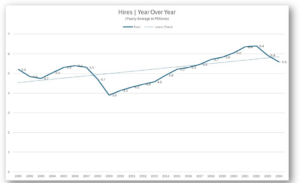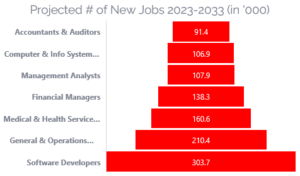Key Insights
- Economic downturns often lead to tighter hiring budgets, with 48% of companies implementing hiring freezes and 30% reducing budgets by 20% or more during uncertain times.
- Market instability increases demand for roles in risk management, financial planning, and strategic leadership, with growth of up to 32% in these areas between 2020 and 2023.
- Non-essential roles often face layoffs during instability, with sectors like retail and hospitality seeing workforce reductions of 22%. Simultaneously, companies focus on strategic hires to maintain operations.
- Companies adapt by reducing non-critical roles while prioritizing strategic functions to navigate market uncertainty, balancing layoffs with selective hiring for essential positions.
Market instability, whether due to economic downturns, geopolitical tensions, or unexpected global events, can disrupt hiring processes. Key considerations include:
Budget Constraints
Economic downturns often lead to tighter budgets. Companies may delay or scale back on hiring, focusing on critical roles to maintain operations.
According to a 2023 report by LinkedIn, 48% of companies implemented hiring freezes during the global economic slowdown, while 30% of businesses reduced their hiring budgets by at least 20% during periods of uncertainty.

Shift in Skill Demand
Market instability can shift the demand for certain skills. For example, during economic uncertainty, there may be a higher demand for roles in risk management, financial planning, and strategic leadership.
A study by McKinsey found that between 2020 and 2023, roles in risk management grew by 28%, and demand for financial planning professionals rose by 32% globally. The World Economic Forum also noted that during times of economic instability, the demand for strategic leadership increased by 25%, particularly in sectors like financial services and manufacturing.
However, while certain areas experience growth, reductions in force (RIFs) and layoffs often become necessary in non-critical or less strategically essential roles.
According to a 2022 Challenger, Gray & Christmas report, layoffs surged by 13% globally during times of market instability, with sectors like retail, hospitality, and entertainment seeing a 22% increase in workforce reductions.
Additionally, the U.S. Bureau of Labor Statistics (BLS) reported that during the 2020 economic downturn, nearly 30% of companies across various sectors reduced their workforce, prioritizing cost-cutting measures to navigate the instability.

This dual impact—layoffs in non-essential areas and growth in strategic roles—underscores how businesses realign their workforce to navigate through uncertainty. Leading up to the election, we’ll be diving into its effects on hiring and how to navigate the changing landscape. Stay tuned for part 3 of Cory’s Corner coming in the following weeks.
We’d like to extend a special thank you to LaborIQ and Mallory Vachon, PhD, Chief Economist for the data and their research for this blog.
Recent Articles
- Understanding Compensation Trends for COOs at Law Firms
- The Value of Working with an Industry-Specialist Recruiter in an Uncertain Market
- 2025 Salary Guide: Product Marketing Managers in CPG
- How Forward-Thinking CPG Companies Are Winning the Talent Race in 2026
- How Much Does a VP of Manufacturing Make in Supply Chain?
- AI is Exploding—Here’s what you’re missing in hiring for AI
- The Rise of Fractional General Counsel
- Avoiding the Costly Mistakes of C-Suite Hiring
- How Much Does a Chief Marketing Officer Make in Cybersecurity?
- What to Know About Chief Risk Management Officer Compensation in Cybersecurity